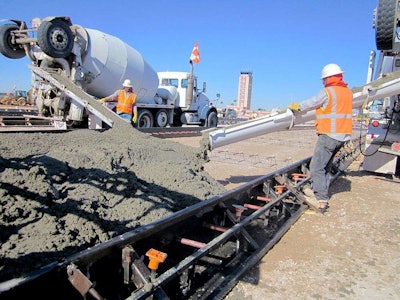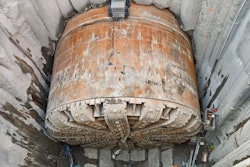
Granite Construction and Metal Forms Corp. (MFC) are working together to on a multi-year terminal apron rehabilitation project at Tucson International Airport. Granite Construction is using MFC’s metal paving forms with built-in dowel holders to “maintain productivity and meet tight tolerances” for the project.
The work is made up of a series of three different depths of Portland cement concrete pavement. The largest is 137,755 square yards at 16 inches deep, followed by 24,194 square yards at 9 inches deep, and 22,495 square yards at 6-1/2 inches deep.
“We’re pouring in 20-foot lanes to meet tight tolerances,” said project superintendent Aaron Tipton. “The corners of every 20 x 20 foot panel have to meet plan elevations to specs within four-hundredths.”
Granite used 571 of MFC’s DUAL Paving Forms that came to 5,700 linear feet in total, in five sizes at 10-foot lengths. The different sizes were needed for varied pavement thicknesses, such as the 16-inch thickness needed for support aircraft traffic and the 9-inch thickness needed to light vehicle traffic near a terminal.
MFC’s forms allow for dowel bar supports, which keep them level and aligned, and grommets on the face of the forms help keep the bars secured during operation. This is key for the project because the Federal Aviation Administration doesn’t allow dowels to be set in after the pour, according to field engineer Bill Carney.
“Using forms with holes and grommets to hold the dowels in place allows us to get them set right where we need them prior to pouring,” he said. “Placing dowels before the pour relieves us of having to drill into the poured concrete.” Form-set dowels, Carney added, saves both time and many over drilling and setting the dowels after pouring.









